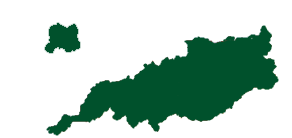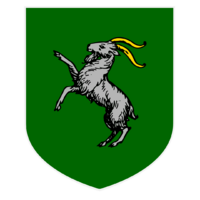Swinas
Federal Republic of Swinas Repubblica Federale di Swinas | |
|---|---|
 | |
| Capital | Cape Cresta City |
| National Language | Italian, Common |
| Ethnic groups |
|
| Demonym(s) | Swish |
| Government | Federal Republic |
• First Consul | Eduard Hoffman |
• Second Consul | Perlita Mele |
| Area | |
• Total | 985,095 km2 (380,347 sq mi) |
| Population | |
• 2021 census | 42,299,153 |
| GDP (nominal) | estimate |
• Total | 448,984,350,000 |
| Currency | Swish Ram, Swish Buckling (SR, SB) |
| Driving side | right |
| Calling code | +59 |
The Federal Republic of Swinas is an Italian speaking nation on the continent of Hiraethia has an island in the Talsar Sea. The nation can trace it's beginnings all the way back to around 150 BCE, but has officially been existing since 1564. The Federal Republic of Swinas shares a border with Vultesia and Wellsenfaile. The country has a dual-consular government, where two consuls are elected by the Swish People and share the powers that the head of the executive branch would normally hold. The Federal Republic of Swinas' government also contains a Senate, which passes legislation which can be vetoed and must be signed by both consuls. Besides on a federal level, the Federal Republic also contains the provinces of Cresta, Tharbarn, Granton, Consilana, Valdona, and Nordinsel. Each of these 6 provinces are represented by the 6 stars on the Swish Flag, with the star in the center representing the Federal Swish Governent.
History
Rise of the Swish People
The history of the region of Swinas as a whole can be loosely traced back to 300 BCE, when nomads began settling in Eastern Swinas and ancient religions began starting in Western Swinas. In the early history of Swinas, the desertpeople were different from the plainspeople. The desertpeople were indigenous Swish, whilst those in the plains came from other areas. The desertpeople believed in different gods and spoke a different language than the plainspeople. One empire from the plains from 150 BCE, the Cristataen Empire, would wish to unite the plains and conquer the desert afterwards. Aries Sabinus, the Emperor of the Cristataen Empire, would raise 4 legions for the conquest of the plains. The Cristataen Empire was the most centralized empire in the plains, and they were able to conquer the plains easily, using new ways of war which had never been seen before by the plainspeople, and building upon the innovations of other tribes in the plains to make new innovations.
The conquest of the Swish Plains would be completed, and the Cristataen Empire would next use their legions to invade the Swish Desert, which was much larger than the plains. The desertpeople would also put up a fierce fight, as they opposed the plainspeople, who they saw as the enemy. After much struggle, however, much of the Swish Desert would be conquered by the Cristataen Empire, and would go on to influence much of modern Swish Culture. Eventually, a succession crisis would lead to the collapse of the empire in 24 CE, and would see the rise of new nations and organizations. Many city-states would be created, who would be united under Swish Leagues. One of these leagues, the Crestan League, would be led by the city of Capcres.
Capcres would organize the Pan-Crestan Conference, in which all of the city-states of the League would meet in Capcres. The envoy of Capcres would begin to discuss plans of further centralization, as the Firinan League would begin showing hostility to the Crestan League. After the conference, Capcres would gain further control of the league, as all of the city-states of the league agreed to become feudatories of Capcres. Following this, Capcres would declare war on the Firinan League and would lay siege to the city which led the league. Following this, a fierce battle would occur. The Firinan League would attempt to use shock action tactics to convince the Crestans that they had a large army than they did, and the Crestans themselves used Single Envelopment tactics, which surprised the enemy and led to a Crestan Victory. The rest of the Firinan League would surrender to the Crestan League, and they would be integrated into the Crestan League, before eventually the whole league was integrated into Capcres.
After this, Capcres culture would also begin to influence the rest of Swinas, as they were a regional power within Swinas. However, the Capcres hegemony would fade away and their territories would be reduced by other nations in Swinas. As communication technology became better, and due to the Cristataen Empire, the divide between the plainspeople and desertpeople was slowly disappearing. Because of this, desertpeople and plainspeople culture was also integrating with each other, creating a unique blend which altogether shaped modern-day Swish culture. This would all occur in the Late Antiquity, and in about 459 CE, Germanic influence from Nordinsel would spread into the region of Swinas. Conquerors from the islands would arrive on the shores of Swinas by around the 400's, and would establish kingdoms in Northern Swinas, which would frequently enter wars with the Swish Leagues.
One of these Nordinselli Kingdoms, the Kingdom of the Hoffs, would conquer most land which is in modern-day eastern Swinas, and would from there expand west into the desert. The Kingdom would then proclaim itself the Hoffic Kingdom of Swinas, but most ethnic Swish would be beneath the Germanic Nordinselli, who at this point dominated Swinas. The geopolitical landscape of Swinas henceforth began to change, with the Hoffs having massive influence over Swinas, including their language. In the periods of Swinas during the antiquity, the majority of Swinas spoke a variation of Latin, now, Germanic language customs would begin spreading into the Swish Language, which would gradually transform into a form of Italian.
Eventually, the Kingdom of the Hoffs would split up into smaller petty Kingdoms, with the Old Swish and Nordinselli cultures fused together, which create the Modern Swish identity. Gradually, another nation which was based nearby the former city of Capcres would rise to power, it's Capital named Cape Cresta City, and it's nation being the Kingdom of Cape Cresta. it would conquer most of Modern-Day Swinas, and later it would also conquer the panhandle into the Parthenean Coast which Swinas owns. The Kingdom of Cape Cresta would last, eventually naming itself the Kingdom of Swinas, and being the absolute controller of all Swish Peoples. Eventually, the Kingdom would launch a 10-year military campaign against the Island of Nordinsel, which while small, was home to some of the fiercest fighters, and would challenge the Swish superiority. Eventually, the island was conquered, and the Kingdom of Swinas would experience a longevity of peace.
Modern Swish History
By the 1400's, the Kingdom of Swinas was a prosperous kingdom which was caught up to the world technologically and culturally. However, the King of Swinas still held absolute power over Swinas, and by the mid-to-late 1500's, many found this an issue. The King's Son, Alberico Rosiello, would be the darling of the Swish People, and many would support his populist ideas. His father, who was still king, believed that his power should remain absolute, and was not willing to transfer some of his power to the people. So, Prince Rosiello along with the people would enter the King's Palace and force the King to transfer his power to his son, who would then go on to make reforms to the monarchy and transfer some of his power to the people. In 1564, the Kingdom of Swinas transitioned from a Absolute to Constitutional Monarchy, and a senate was established with 100 seats, and people could vote on who to elect into it, and they passed legislation.
The transition would be received well by the Swish People, but by 1643, a new King named King Oscuro II would seek to consolidate his power, and he would begin using the military to repel certain legislation from the senate from being passed. The people, not in favor of this, would revolt, and the King would abdicate. In order to prevent a new King from taking too much power, the Kingdom of Swinas would transform into the Federal Republic of Swinas. The Senate was given greater power, and the powers of the king would be shared by two people who were the First and Second Consuls. The provinces were established, and this system has been in place for 400 years with little change.
Government
The Government of Swinas will now be explained in full depth. The Government of Swinas is divided into 3 echelons, the first being the Consuls, the next being the Senate, and finally the Provinces. The consuls are the easiest to explain, and will be discussed first. The requirements to become a consul are that you must be at least 30 years old, you must have been a member of the senate for 5 years, and you must be born in Swinas or your parents were born in Swinas. The two consuls share the power to veto and approve legislation, but if the Senate counters the veto with a 75% majority then it is passed regardless. The two consuls must both sign legislation before it is passed.
Then there is the Senate. The Modern Senate is comprised of 100 members, but this number has changed throughout history. To be a member of the Senate you must be 20 years old. A senator has one vote each, and a simple majority of 51/100 can pass a law. If both consuls veto a law, then it can be countered by a 75/100 majority, which will override the Consul Veto and force the law to be passed. The Senate has some limitations per what laws it can pass due to the constitution, mainly that it cannot impede upon the established Bill of Laws. Laws in the Bill from the beginning of the Federal Republic cannot be easily removed, but newer ones are easier to remove.
Lastly there is the provinces. Each province has a governor who can choose to follow or not follow certain legislation passed by the Senate. In addition, the Governor acts as the only Consul of his Province, as their is also a Provincial Assembly in every province which has a member count proportional to it's population. These provincial assemblies can only pass laws which involve the province they are in, however. The consuls, senate, and provinces altogether make up the Modern Government of Swinas, which has been in place for 400 years and is still stable today.

